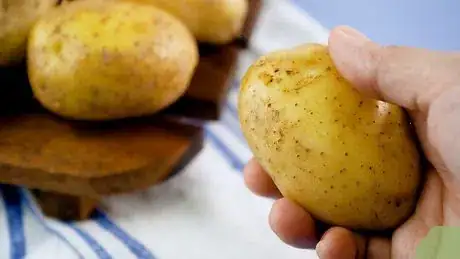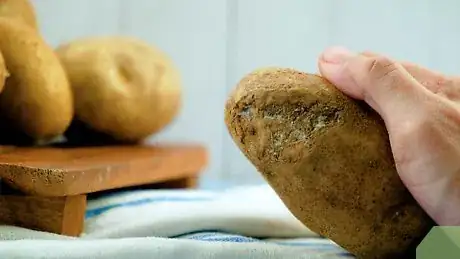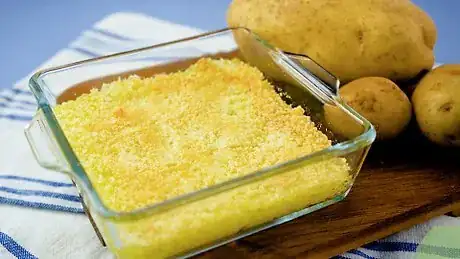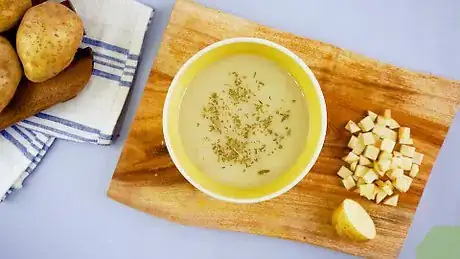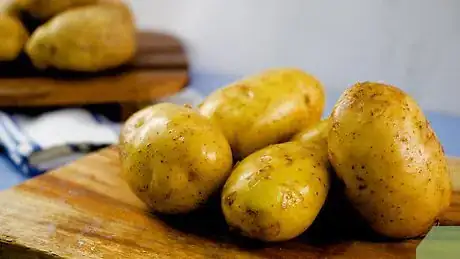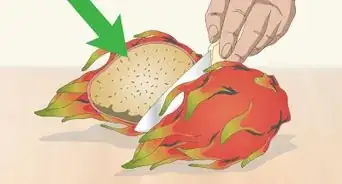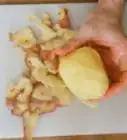This article was co-authored by Olivia Choong. Olivia Choong is a Plant and Gardening Specialist and the Owner of The Tender Gardener. With more than six years of experience, she specializes in gardening, permaculture, and self-sufficient and low-impact living practices. Her work has been featured in media outlets such as The Straits Times and Channel NewsAsia (CNA). Olivia holds a Bachelor of Mass Communications in PR and Journalism from Murdoch University.
There are 7 references cited in this article, which can be found at the bottom of the page.
This article has been viewed 47,915 times.
Potatoes are a staple in many diets all across the world, and these versatile tubers can be cooked in an endless number of ways. From fried to baked to roasted to boiled and hashed, there's no limit to what you can do with a potato. Cooking with potatoes starts with choosing the ripest and healthiest ones. There are also a great number of potato varieties, and it’s important to select the right one based on the dish you want to make.
Steps
Picking Ripe and Healthy Potatoes
-
1Squeeze potatoes for firmness. The best potatoes are ones that are firm and that don’t give when you squeeze them. Getting soft is one of the first indications that a potato is going bad, so avoid potatoes that feel squishy or soft when you squeeze them.[1]
- Although soft potatoes are safe to eat if you already have one at home, avoid buying them from the store unless you plan to cook them immediately.
-
2Check for cuts and blemishes. Cuts and blemishes can lead to decay, and they can also provide a place where bacteria or mold can get into the potato. When choosing potatoes, turn them over and inspect all sides for gouges, dents, cuts, and other open spots in the skin.[2]
- Potatoes with minor surface blemishes are safe to eat, as long as you cut away the affected area. You'll get more potato for your money if you buy potatoes that are clean, smooth, and unblemished.
Advertisement -
3Smell potatoes before buying them. Because potatoes are grown in the ground, it’s normal and natural for them to smell faintly of soil. Before adding a potato to your cart, put it up to your nose and inhale.
- Although potatoes should smell faintly of soil, the skin should be relatively clean and free of dirt.[3]
-
4Buy sprouting potatoes only if you're going to eat them immediately. Potatoes that are growing eyes have started to sprout. While these are still safe to eat, they should be eaten right away. Don’t buy sprouting potatoes unless you're going to cook them within a day or two.
- Before cooking, dig out any eyes that are growing from the potato with a spoon or cut them off with a knife.[4]
-
5Don’t buy wrinkled potatoes. Wrinkles in a potato can be a sign of many things, including mishandling (which also leads to bruises), moisture loss, and the potatoes being stored in too warm a temperature.
- Instead, look for potatoes that are smooth and plump.[5]
-
6Avoid potatoes with green skin. Potatoes grow underground, so if they're exposed to the sun, it means they're vulnerable to predators. To protect themselves, potatoes produce a chemical called solanine, which makes the potato taste bitter and unappealing. When eaten in large quantities, solanine can cause gastrointestinal discomfort, diarrhea, and hallucinations.
- Potatoes with a shallow layer of green buildup are safe to eat, as long as you cut away the affected portions. You'll get more for your money if you avoid green potatoes.[6]
-
7Don’t buy potatoes with darks spots or bruises. Dark spots and bruises should be cut away before a potato is eaten, so it’s best to buy potatoes that don’t have any such flaws. Turn the potato over in your hand and look for black spots, dark areas, and bruises that would have to be cut away.[7]
- Bruising is typically a sign of rough handling, but dark spots can also be a sign of blight or fungal infection.
Choosing a Potato Variety for Cooking
-
1Pick starchy potatoes for dry or oil-based cooking. Potatoes that are high in starch absorb lots of liquid, so they tend to fall apart in soups, stews, and when boiled. But they're great for dry cooking methods like baking and roasting, and oil-based cooking methods like frying. Starchy potatoes can also be mashed, and they pair well with butter, gravy, sour cream, and other sauces. Starchy potatoes include:[8]
- Russets
- Sweet potatoes
- Idaho
-
2Go with waxy potatoes for steaming and boiling. Waxy potatoes contain low amounts of starch. They don’t absorb liquid the way starchy potatoes do, so they don’t fall apart when boiled, steamed, or cooked in soups and stews. These are also great potatoes for potato salad, chowders, and casseroles, because they hold their shape when cooked. A few waxy, low-starch potato varieties are:[9]
- Fingerlings
- Yukon Gold (low to medium starch level)
- Carola
- LaRette
- Austrian Crescent
-
3Opt for an all-purpose potato when you don’t know what you need. All-purpose potatoes contain medium amounts of starch, so they’ll absorb water when cooked but also hold their shape better than high-starch varieties. These potatoes can be steamed, boiled, baked, fried, and cooked in soups and stews, but they're ideal for gratin and roasting.[10] Medium-starch all-purpose potatoes include:[11]
- Goldilocks
- Kennebec
- Onaway
- Elba
- Red potatoes
- Purple potatoes
- All Blue
-
4Use new potatoes when you want to cook a whole potato. New potatoes are potatoes that are harvested before they fully mature. They have a tender and thin skin, so they don’t need to be peeled before they're cooked. Because these potatoes are smaller and have a thinner skin, they're ideal for boiling or steaming whole.[12]
- Once cooked, whole new potatoes are often tossed with butter, oil, and seasonings like salt, pepper, garlic, and herbs.
- The term new potato can refer to any kind of potato, because “new” refers to the age and maturity of the potato, not the variety.
-
5Choose russets for oil-based cooking methods. When you eat French fries, most of the time they’ll be made with russet potatoes. This variety of potato works great with oil-based cooking methods like frying and sautéing. Other dishes where russets are ideal are:[13]
- Hash browns
- Latkes
- Potato wedges
Storing and Keeping Potatoes
-
1Transfer potatoes to a paper bag for storage. Potatoes will last for several months when stored properly. The best way to store potatoes is in an open paper bag, or a paper bag with several holes punched into it. This allows the air to circulate and prevents moisture from building up inside the bag.[14]
- Plastic bags are not recommended for storing potatoes, because they trap moisture and can lead to premature rotting.
-
2Store them in a dark place. Potatoes that are exposed to the sun will begin to produce solanine, so it’s integral to keep potatoes in a dark location away from sunlight. Countertop storage is not recommended. Good places to keep potatoes include:[15]
- Root cellars
- Pantries
- Cupboards
- Closets
- Cabinets
-
3Pick a slightly cool location for storage. The ideal temperature for storing potatoes is between 45 and 50 F (7 and 10 C).[16] This is why root and cold cellars are best for potatoes, but dark pantries and cupboards will also work.
- Do not store potatoes in the refrigerator, because the excessive cold will cause the starch to convert to sugar, changing the flavor of the potato.
- Potatoes that are stored at room temperature will only last for one to two weeks, as opposed to two to three months.
-
4Store them in a dry, ventilated location. Moisture can cause potatoes to spoil quickly, so you need to find a dry location where they can be kept. A dry location that’s also cool, dark, and well-ventilated will prevent sprouting and early spoilage.[17]
- For houses with wet basements, a cupboard or pantry will be more suitable for potatoes.
Community Q&A
-
QuestionHow do I cook potato wedges?
 KateKatey GirlCommunity AnswerPlace the wedges on a sheet pan, sprinkle a bit of olive oil (or vegetable, your choice), then season the wedges to your liking (always salt and pepper, optional seasonings: garlic powder, onion powder, ranch seasoning, cayenne pepper or red pepper flakes if you like them spicy) Place them in a preheated (400 degee) oven and cook until done to your liking! You can stir or flip them halfway through to cook them evenly if you like
KateKatey GirlCommunity AnswerPlace the wedges on a sheet pan, sprinkle a bit of olive oil (or vegetable, your choice), then season the wedges to your liking (always salt and pepper, optional seasonings: garlic powder, onion powder, ranch seasoning, cayenne pepper or red pepper flakes if you like them spicy) Place them in a preheated (400 degee) oven and cook until done to your liking! You can stir or flip them halfway through to cook them evenly if you like -
QuestionWhat are the British varieties of potatoes called?
 Community AnswerKing Edward, a floury potato with white skin and pink eyes. Marabel, one of the best potatoes for mashing thanks to its incredibly creamy texture and rich, sweet flavor. Other varieties include, Maris Piper, Osprey, Purple Majesty, Rooster, Russett. and Vivaldi.
Community AnswerKing Edward, a floury potato with white skin and pink eyes. Marabel, one of the best potatoes for mashing thanks to its incredibly creamy texture and rich, sweet flavor. Other varieties include, Maris Piper, Osprey, Purple Majesty, Rooster, Russett. and Vivaldi.
References
- ↑ https://www.potatogoodness.com/buying-storing-potatoes/
- ↑ http://www.streetdirectory.com/food_editorials/health_food/vegetables/how_to_buy_store_and_prepare_potatoes.html
- ↑ http://www.epicurious.com/ingredients/how-to-buy-and-store-potatoes-like-a-pro-article
- ↑ https://www.potatogoodness.com/buying-storing-potatoes/
- ↑ http://www.epicurious.com/ingredients/how-to-buy-and-store-potatoes-like-a-pro-article
- ↑ http://www.streetdirectory.com/food_editorials/health_food/vegetables/how_to_buy_store_and_prepare_potatoes.html
- ↑ http://www.bonappetit.com/columns/in-season-now/slideshow/buy-store-cook-storage-potatoes-season-march
- ↑ http://www.thekitchn.com/potato-varieties-64061
- ↑ http://www.gardeners.com/how-to/potato-varieties/7556.html
- ↑ http://www.finecooking.com/articles/best-potatoes-to-mash-bake-or-boil.aspx
- ↑ http://www.thekitchn.com/potato-varieties-64061
- ↑ http://www.gardeners.com/how-to/potato-varieties/7556.html
- ↑ http://www.gardeners.com/how-to/potato-varieties/7556.html
- ↑ http://www.epicurious.com/ingredients/how-to-buy-and-store-potatoes-like-a-pro-article
- ↑ http://www.bonappetit.com/columns/in-season-now/slideshow/buy-store-cook-storage-potatoes-season-march
- ↑ http://www.streetdirectory.com/food_editorials/health_food/vegetables/how_to_buy_store_and_prepare_potatoes.html
- ↑ https://www.potatogoodness.com/buying-storing-potatoes/
About This Article
Choosing perfect potatoes depends on how you plan to use them. If you’re frying or roasting potatoes, look for a starchy variety like Russet or Idaho potatoes. Waxy potatoes, like fingerlings and Yukon Gold, are best for boiling and steaming. Waxy potatoes are also good in potato salads, stews, and casseroles because they hold their shape when they are cooked. If you want to cook a whole potato, choose a new potato, which has a thinner skin that doesn’t need to be peeled. If you want to learn how to check if your potatoes are ripe, keep reading the article!
